
As I’ve mentioned before (e.g. here and here) the field of human evolution is one that has long fascinated me and I could have quite easily been deflected into paleoanthropology as a profession had not the lure of plants and pollinators been stronger. So I’ve followed with interest this week’s fascinating announcement of the ancient origins of some enigmatic structures found deep within a French cave complex. The journal Nature published the research paper by Jaubert et al., and has produced a wonderful accompanying video that you can view here.
Something struck me as I watched this video for the 3rd or 4th time: the aerial view of the structures seen at about 48 seconds looks very like the head of a young mammoth, seen from the front, with the mounds representing the two eyes and the smaller circle lower left a curling trunk. There’s even a large stalactite/stalagmite positioned where we might expect to see a small tusk.
Mammoths were hunted by Neanderthals and we know that they made structures (possibly dwellings) from their bones. Much later, Palaeolithic humans painted prey animals such as mammoths on the walls of caves. OK, if it is a mammoth it can only be viewed from above, but then that’s also true of the Nazca Lines.
So is it completely bonkers to suggest that these Neanderthals were building representations of animals they were familiar with in these caves? We are very good at seeing patterns in otherwise random assemblages of markings, for example the face of Jesus in a rock or on a frying pan, or tomatoes, cats and houses that look like Hitler. But this is rather different – we know that the structure is not natural, it was constructed. We don’t know why it was constructed or what, if anything, it was meant to represent. Perhaps a mammoth is not too fanciful an idea?

Thinking of the most mundane of necessities, maybe the people sheltered there from time to time, and slept within walls of broken stalagmites to stop the babies crawling off into the dark. I would imagine that, with no easy sources of light, they would have had to build something like that.The present is the key to the past, and all that. :)RegardsSteve H From: Jeff Ollertons Biodiversity BlogSent: Friday, 27 May 2016 12:42To: steve.a.hawkins@ntlworld.comReply To: Jeff Ollerton’s Biodiversity BlogSubject: [New post] Wild speculation: could the Bruniquel Cave Neanderthal structures represent a mammoth?
a:hover { color: red; } a { text-decoration: none; color: #0088cc; } a.primaryactionlink:link, a.primaryactionlink:visited { background-color: #2585B2; color: #fff; } a.primaryactionlink:hover, a.primaryactionlink:active { background-color: #11729E !important; color: #fff !important; }
/* @media only screen and (max-device-width: 480px) { .post { min-width: 700px !important; } } */ WordPress.com
jeffollerton posted: ”
As I’ve mentioned before (e.g. here and here) the field of human evolution is one that has long fascinated me and I could have quite easily been deflected into paleoanthropology as a profession had not the lure of plants and pollinators been stronger. “
Yes, agreed, there could be any number of more mundane explanations for this structure. It may be that we never know.
I have visited the Cougnac cave in the Lot region of France. There is a large “room” with broken stalagmites of different heights. I was told these had been broken on purpose and had indentations where they had been struck to produce different “notes”. I’d like to imagine everyone sitting around in more or less a circle in the Bruniquel cave with a few pieces of stalagmite each having a bit of a rave. They must have done something to keep amused during the long winters. Amelia